Tinder, sometimes known as kindling and a camp fire starter are all essentially the same. It’s easy to start a fire with this because of its flammability. Camp fire starter’s common components are sawdust, fabric fibers, wax, and recycled paper. Here, we will share some of the most fundamental things that you must know about camp fire starters.
Which Kind of Wood Should I Choose?
Always be sure to utilize wood that has fallen to the ground. This wood will not be green but dead, making it simpler to burn. Prepare an inventory of your wood when you get it:
- A heap of very little dried bits that are not longer than the length of a match stick. These are going to be the sparks that ignite the fire.
- Build a second stack using sticks that are not larger than a pencil’s diameter or less.
Where Should I Set Up the Camp Fire at the Campground?
You should use an existing fire ring rather than create a new one. Some parks prohibit creating new fire rings. Try to find pre-existing fire pits in other regions that are well-known for their popularity among campers.
If possible, build your camp fire starter in an area close to a water source. You’ll need it to ensure the fire is entirely extinguished, and you don’t want to waste valuable drinking water if you’re not close to a water supply.
Start the Fire Using a Magnifying Glass
A curved lens may concentrate enough sunlight on a bright day to spark a fire. You may use eyeglasses, lenses from your camera, magnifying glasses, or even the lenses from your binoculars or telescope.
Keep the lens pointed towards your fuel so the light can reach it. Then, you must wait in the meanwhile and please be patient. The fuel will start to smoke and catch fire eventually.
Create Fire with Flint and Steel
If you don’t have a flint-and-steel camp fire starter, you may produce a spark by brushing the blade of your knife against flint, a hard, grey rock that breaks easily. These can be purchased from outdoor stores or shops or wholesaled from manufactures like Deermaple.
Create a softball-sized nest out of your fuel. Try to aim the flint’s sparks into the tinder by holding the flint a few centimeters above it. Gently blow on the spark to help it grow into a flame. If necessary, add camp fire starters and gasoline.
Methods for Maintaining the Fire at a Campsite
Add more wood to the pile of burning wood while the fire burns. Adding too many logs at once increases the likelihood that the fire will be smothered and extinguished. Burn only dried wood and paper, paper products, such as package wrapping. You should throw away or recycle any cans, plastic, or aluminum foil you may have.
Making a Campfire: Safe Practices to Follow
Ensure you always use properly excavated and lined sand and gravel fire pit. Use a lot of water or sand to put out the fire. A fire should never be left unattended. Young children should be kept at least three feet from the fire pit, and any potential trip hazards should be removed.
Using a camp fire starter directly on the ground is not a good idea. The fire may have been put out on the surface, but the roots might still smoke underneath. Never start a fire using flammable materials such as BBQ lighter fluid. Green wood doesn’t burn and isn’t good for the environment.
You should have a bucket of water handy in case of a fire. Take the whole carton, or peel out as many individual bags as you can to start a camp fire.
Instructions for Putting Out a Campfire
As everyone knows, much water is the best way to extinguish a fire. Sand, mud, and other materials that trap oxygen may also help you extinguish a fire. Ensure the whole foundation and each log is soaked in water while putting out the fire. Knock the logs to the floor with a stick or fire poker to extinguish the fire.
To ensure no hot ashes are hidden beneath the surface after the fire has been dismantled, soak the logs in the water and stir the ash with a long object as you pour water on the ground. It is recommended to break up any huge logs left on the fire before putting it out since the inside of a log might still catch fire even if the outside is not burning.
Furthermore, while camp fire starter is helpful, you must collect kindling and bigger logs to keep the fire burning. A fire built entirely out of fire starters would burn brightly, quickly, and cost a lot of money. While some kindling is sufficient, having more than one ignition source is preferable.




